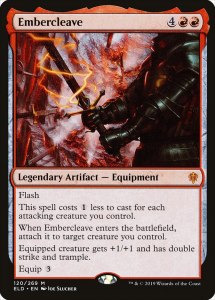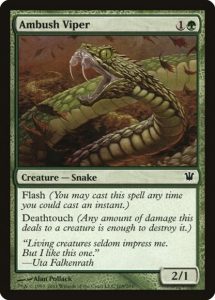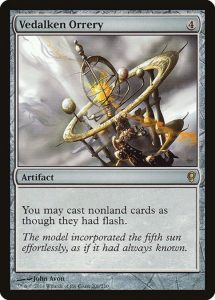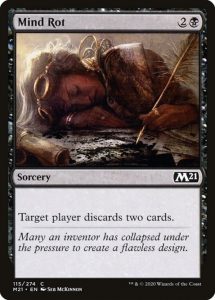Table of Contents
Over its almost 30 years of existence, Magic: the Gathering has added a ton of keywords and mechanics to the game. While many of these mechanics may not be usable in rotating formats like Standard, you do have access to all of them in eternal formats like EDH. This can lead to many questions about how all these mechanics work.
One popular example of a mechanic is Flash. In today’s post, I’ll be explaining why flash is good in MTG, as well as answer some questions about it.
Note: For those more experienced, we are going to be discussing the keyword Flash, not the card of the same name. We may discuss Flash the card in a later post.
What is Flash?

Before I get into the benefits of Flash, let’s start with filling in any beginners about what it is. If you’re unfamiliar with the term, Flash is a keyword in Magic: the Gathering that allows cards to function as if they were Instants.
When someone casts a spell, that spell goes into what’s called “the stack.” You can think of the stack as a line that each spell waits in before it resolves or its effect happens. Instants are cards that skip the wait and go to the front of the line, getting cast first.
The thing about Instants is they don’t stick around once they’re finished. Generally, their effect happens, then they immediately go into your graveyard unless you have some way of stopping it from going there.
This isn’t usually the case with Flash. Because it’s typically a keyword on a permanent, it allows you to cast a card at Instant speed that will likely stay on your battlefield.
As an example, look at the above card, Embercleave. Embercleave is a popular card to cast at the last second once you’ve decided to attack someone. Because it has Flash, it can be cast at any time and immediately, just like an Instant.
This is Why Flash is Good
1. Because you can cast at any time with Flash, you can wait until the last possible moment.

Magic is a game about strategy. As with many other strategy games, it’s sometimes better to know what your opponents are going to do before you take action. This can oftentimes lead to stand-offs in MTG, where players are staring suspiciously at each other over the table, waiting for someone to make the first move.
Flash helps make the strategy of sitting back and waiting more plausible. With a Flash card that you can cast at any time, you can wait to have more information on what your opponents are going to do before you tip your hand.
An example of when this is useful is during combat. We’ll use Ambush Viper, pictured above, as an illustration.
Say someone is attacking you with their biggest, scariest creature. If you had Ambush Viper out on the field already, they’d probably refrain from doing so, because they’d know you could kill their creature by blocking with Ambush Viper, which has Deathtouch. The better strategy is to wait until they declare they’re attacking you, then cast Ambush Viper after their declaration to block their attack unexpectedly.
2. If you cast a permanent with Flash at the end of an opponent’s end step, you don’t have to worry about them using a Sorcery to remove it.
In some ways, casting a creature with Flash at the end of an opponent’s end step is kind of like giving it haste. Because it will have technically been cast on a previous turn, you’ll be able to attack with it when it is your turn again.
However, because you brought the creature out at the end of your opponent’s end step, they can’t use any Sorcery-speed cards to get rid of it. They could only use an Instant…assuming they have access to one.
3. Flash allows you to leave your mana open and keep it available for various situations.
This is kind of like #1 on our list, but with one crucial difference. Cards with Flash indirectly give you some versatility.
For example, say you have an Instant and a card with Flash in your hand. There’s no pressure to tap out all of your mana at the end of the turn with these options. You can keep both cards in your hand, leave some mana open, and wait to decide which one you will use based on the actions your opponents may take.
4. Flash can promote psychological warfare.
Like any other strategy game, much of Magic: the Gathering takes place inside the battlefield of the mind. You can sometimes win a game just by having a great poker face and some solid bluffing skills to match.
How does Flash fit into that? Think about it – Flash is an ability that allows you to play a card at any given time. If your hand is a dud but your opponent knows you might have an answer with Flash, then you can leave some mana open at the end of your turn.
Then sit back and watch your opponents debate with themselves if attacking you is really worth it. Do you have an answer? Could you kill their best creature? They’ll never know, and they might not be willing to find out.
5. With the right deck, you can use Flash as a form of Stax, forcing opponents to discard on their draw step.


If you’ve never heard of Stax, it’s a Magic slang word that refers to a particular strategy. Stax decks seek to shut down the entire game by stopping players from drawing or casting cards…or taking pretty much any action, really.
Usually, a Stax deck has some kind of alternate win condition built into it so that you can still take actions, but your opponents can’t. Again, what does this have to do with Flash?
Well, at the beginning of their turns, your opponents have a draw step. Generally, cards that force your opponent to discard are Sorcery-speed, meaning you can’t usually force your opponents to discard cards they just drew. The reason for this is obvious: your opponents will almost always have that opportunity to draw to keep the game moving forward.
However, if you have something that gives all your cards Flash, like the above Vedalken Orrery…you could potentially force opponents to consistently discard on their draw step, basically throwing all the cards not already in their hand away. The way to do so would be combining a card like Vedalken Orrery with a card that forces opponents to discard, like Mind Rot.
To be honest, we think this is kind of an obscure strategy, but it can still be powerful. Keep in mind, though, that it wouldn’t be very fun to play against, and you might find people avoiding games with you if you use this type of strategy often.
This is the Drawback to Using Flash
1. Inexperienced players might not know when to use a card with Flash.
Flash is a deceptively simple mechanic. It’s one of those things that’s easy to learn, but difficult to master. An inexperienced player wielding a card with Flash might immediately think to themselves, “I can cast this whenever I want!”
This tends to lead to two different outcomes. A novice might choose to cast the card with Flash whenever they felt like, missing the opportune moment. More cautious beginners, on the other hand, might choose to hold onto the card indefinitely, waiting for that “perfect” moment that never comes.
A card that’s never cast at all and one that’s cast at the wrong time are equally useless. Determining when to use a card with Flash takes experience, as well as knowledge of how different play groups work together.
Flash FAQs
Do cards with Flash have summoning sickness?
Yes, creatures with Flash have summoning sickness, just like most others. That being said, you can indirectly get around this by casting a creature with Flash during an opponent’s turn.
By the time your next turn comes around, since the creature was technically cast on a previous turn, you will be able to attack with it.
Wrap Up
I hope this post taught you a little more about the Flash mechanic. It wasn’t until I finished writing this post that I realized people are probably wondering about Flash the card and not necessarily the keyword…so I guess that discussion will get shelved until later.
At any rate, now this entry is here in case you had any questions about cards with Flash. If there’s anything I missed that you’re still wondering about, feel free to drop your questions in the comments below.
If you loved the Ikoria: Lair of Behemoths set as much as me, be sure to check out our post on how Mutate works.
